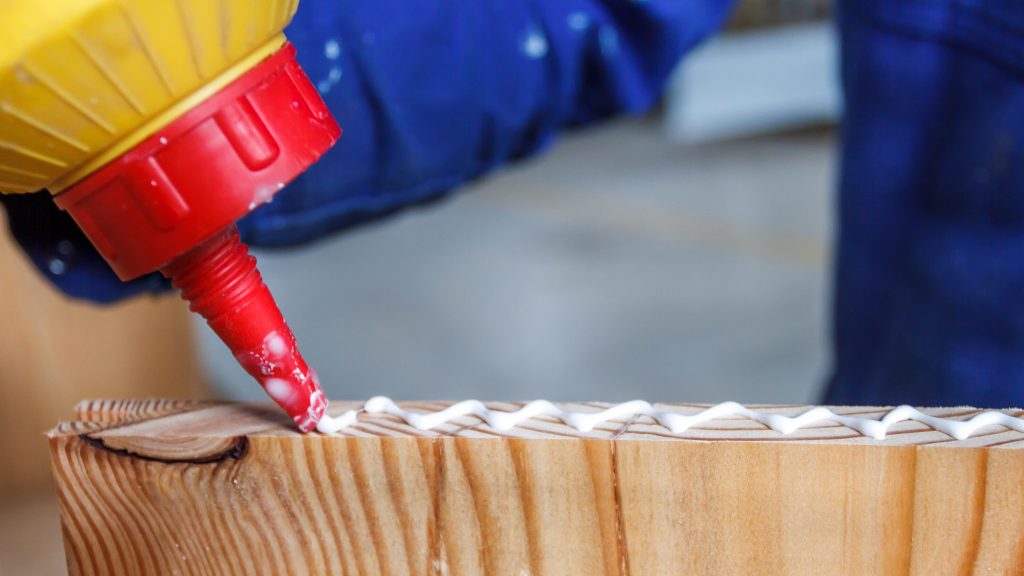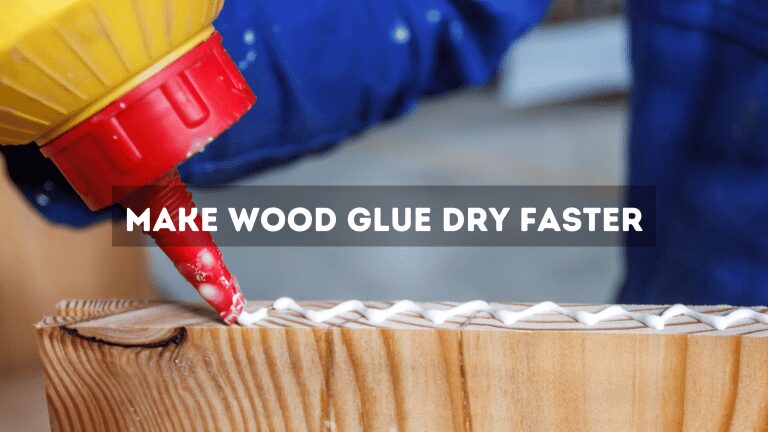So are you looking for the practical tips on how to make wood glue dry faster? You’re on the right page.
The wood glue is an important agent for sticking two woods together. It serves almost all types of wood products from furniture to floors. For its mere importance, wood glue assumes several types, strengths, qualities, and drying capacities.
As to how fast a wood glue dries eventually depends on its type. For some, this can be frustrating especially in cases wherein they need a quick drying result.
To address that frustration, we’ve gathered in this article the tips that actually work.
Read this article to ensure a fast woodwork result today.

Table of Contents
Types of Wood Glue
So why do we need to be informed about the several types of wood glue? Does it help to make the wood glue dry faster?
To be honest: it does.
Knowing the types of wood glue does not only help you nail a fast-dry result, but also provides you full control over the wood glues of your choice.
Here are the common types of wood glue….
1. Polyurethane Glue
Polyurethane glue affirms as one of the strongest wood glues on our list. With proper and diligent application, it is sure to provide 100% effectivity on wood, not to mention that it’s also one of the fastest-drying glues around.
However, this type of glue requires knowledgeable handling from the user in order to take effect. Not following the right procedures for applying would instantly spell disaster.
Unlike most glues, it does not cause wood joints to bulge. As a result, experts recommend it for its non-water-based solution.
But what does its non water-based solution have to do with its neatness?
Simple. It does not attract moisture to gather inside the wood after exposure. In fact, it proves more efficient to the point that it seals the wood surface.
So, all-in-all, it’s an effective type of wood glue, but also crucial when it comes to application.
>>Click the link here to check our favorite polyurethane wood glue.<<
2. Epoxy Glue
The epoxy glue plays out as one of those wood glues that are water-based yet are also water-proof. Epoxy glues also champion as one of the strongest adhesives in the industry.
Another great thing about the epoxy glue is that it’s bond strength is directly influenced by its length of curing time. Since most glues have a more stable cure time, then it apparently has a strong bond.
You won’t have to worry about its bond losing its viscosity over time because it’s waterproof. In fact, the epoxy has proven to stay in grips for years.
Because of this unique advantage offered by the epoxy glue, experts recommend it as not only safe, but great filling for joints.
The main problems with the epoxy glue have to do with thermal instability and the fact that it’s difficult to remove from wood without causing chips and scratches on its surface.
>>Click the link here to check our favorite epoxy glue.<<
3. Cyanoacrylate glue
The ultimate edge of the cyanoacrylate glue or simply known as CA from other glues is its holding quality. Indeed it isn’t as strong an adhesive as most glue types, but it sure does offer distinct benefits when need arises.
Since it isn’t built for strong clasping, it can resist impact and still give in to your desire of detaching it. In simple terms, you can easily remove it if you want to since you can hit it anytime, for instance, and expect it to be intact.
In addition, the glue’s high holding tendency makes it a perfect adhesive for clamps and wedges.
>>Click the link here to check our favorite cyanoacrylate glue.<<
4. Animal glue
If you’re planning to DIY your glue product, chances are that you’ll end up with the animal glue. This type of wood glue has been around for years. It has since been the raw glue to have ever graced mankind.
Like the PVA glue, this one entails straightforward application on wood. Moreover, one can easily make it in the home.
Are there commercial versions of the animal glue?
Yes — there are, of course, albeit less accurate when it comes to wood support.
It’s got a fairly on-point holding jurisdiction on wood. But compared to its later versions like the types we mentioned beforehand, it does not stand a chance, especially when it comes to holding strength.
When push comes to shove that you have to make your own wood glue, animal glue becomes inevitable.
Other names for animal glue include the hide glue, rawhide glue, and the synthetic Titebond Hide Glue.
>>Click the link here to check our favorite animal/hide glue.<<
5. Polyvinyl glue
Known formally as polyvinyl acetate glue, this type of glue champions as the most common, affordable, and readily-available glue in the market. Experts regard them as the practical woodworker’s glue.
When it comes to application, the polyvinyl glue or PVA ranks as the most straightforward wood application to ever rule the industry today.
Moreover, the PVA glue does not easily break and fade through time. Most of its variants (it has the most number of variants among the rest) stay on the wood surface without affecting its condition. Ultimately, it emits the least to no smell upon application.
So, it should be safest to use.
The only emergent problem with this glue type is the fact that it’s too hard to remove from wood. But otherwise, it should be perfect.
>>Click the link here to check our favorite polyvinyl glue.<<
Now that you know the common types of wood glue, it’s time to learn the practical tips on how to make wood glue dry faster.
Read on…
Practical Tips on How to make Wood Glue Dry Faster
The tips that we will be presenting wherein include a wide range of options from the most practical to the most ideal. Apparently, you can expect that most of these tips on how to make wood glue dry faster are do-it-yourself in nature.
Depending on your specific situation, one tip might work perfectly for you while another might not. It is therefore crucial that you understand the specific needs given your situation.
Let’s not take you long. Here are the tips…
Tip #1. Avoid adding water.
- Make sure your glue isn’t sticky enough.
- Do not mix contents in the glue. Just apply and then spread it as how it’s usually doine.
- Do not overapply. One thin layer makes for the fastest dry-up.
Tip #2. Apply the clamp method.
- Design the woods to fit them for clamping.
- Hold them together to clamp.
- Check if the joints are tightly clamped.
- Apply holding points on the joints.
Tip #3. Secure sufficient ventilation in the area.
- Make sure air finds its way in the traffic of your working space since it helps make wood glue dry faster.
- If necessary, work somewhere directly in front of an open window. Better yet, work in an open space.
- Another option is to work somewhere warm since warm air sucks in glue moisture fast.
Tip #4. Apply the one-strike-layer rule.
- Apply a thin layer on the joints with just one strike.
- Do not move the direction of your application. For instance, if you’re going along the grain of the wood, keep it in that direction. Don’t go opposite.
- Apply only one layer.
- Blow-dry the glue if necessary.
Tip #5. Switch to a newer glue.
- Check on the details of the product like expiry date, manufacturing details, brand, and container/package placement.
- Inspect the color or luster of the glue.
- Inspect the outside nature or freshness of the glue container.
- If none of these standards that are supposed to make wood glue dry faster just don’t work, then it’s time to switch to a newer glue.
Tip #6. Add sawdust.
- Purchase a quick-dry glue or epoxy.
- Mix thoroughly 2 pinches of your glue solution with a pinch of sawdust.
- Plan and mark ahead of time where you’re planning to apply the glue since it would prove too difficult to adjust its placement once put.
- Apply immediately.
Continue reading to hear our conclusion…
Check here How to Remove Gorilla Glue from Wood
Final Thoughts
The tips on how to make wood glue dry faster are apparently practical. They also prove most effective if followed and done to the last detail. These tips aren’t that difficult anyway.
Another crucial aspect that ensures success in quickly drying wood glue is knowing the type of glue one is using. There are a lot to choose from. At the moment, the wood glue has 5 common types – animal glue, polyvinyl, polyurethane, epoxy, and cyanoacrylate.
Out of these 5 common types, the fastest-dry and strongest ones are polyurethane and epoxy. The most popular polyurethane glue brand in the market today goes with the name Gorilla glue.
The rest of the types are nevertheless great on wood. But you’ll have to determine your situation first and foremost, before you’d get to decide which wood glue product/type to use.


